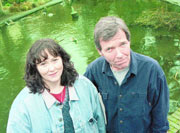TIM AND PATTY Crawford don’t call themselves environmental zealots. But since they purchased their three-quarter-acre lot in Shoreline five years ago, a cozy fenced property with a salmon stream running through the middle, they’ve become seasoned advocates for the stream and its beleaguered wildlife. They say they’ve had no choice.
First, the city of Shoreline proposed building a new fire station next to Thornton Creek, right on the lot the Crawfords own. Next the city refused to stop an upstream neighbor from putting a backyard cottage next to the creek. So the Crawfords, armed with the city’s own environmental rules, sued the city and landowner. Then two years ago, the Crawfords tackled an even more daunting cause: trying to prevent a massive retirement center from being plunked down on the banks of Thornton Creek. So far, they’ve won some hard-fought battles, but the fight is costing them heavily, both in dollars and personal trauma. This is a story of how far one couple is willing to go to save its stream. And there’s still no end in sight.
SEVEN MONTHS AGO, the Crawfords thought their troubles were over. They emerged victorious from King County Superior Court, having won a lawsuit that halted construction of the proposed retirement center not far downstream from the Crawfords on N.E. First in Shoreline, a suburb just north of Seattle. But last week, Tim was in court facing charges of burglary and harassment that he allegedly committed on the site of that same project, owned by Aegis Assisted Living, which is based in Redmond. Aegis’ construction foreman says Tim’s opposition tactics literally stepped over the line, accusing Tim of trespassing on the company’s site and obstructing construction. Aegis has also filed suit in county court, claiming the Crawfords and 50 other Shoreline residents allegedly slandered and libeled the company at a neighborhood meeting. This legal onslaught by Aegis is the most personal yet in its scrap with the Crawfords, who contend that the city of Shoreline is sacrificing salmon to economic development by refusing to keep Aegis’ development back from Thornton Creek, home to the threatened chinook and various other salmon species.
At issue is the recuperative potential of Thornton Creek, which flows off the largest watershed in Seattle and is the city’s only remaining habitat for chinook salmon. (see “Where’s the City?” p. 20). The waterway is by no means picturesque for most of its 15-mile run to Lake Washington. Private development has stripped its banks of trees and shrubs, and flood walls have shaped it into a narrow channel that is inhospitable to fish. Still, cutthroat trout and coho salmon populate the stream in hardy enough numbers that river otters swim the creek to hunt them. Seattle Public Utilities has dedicated millions of dollars to help restore the creek, and a recent proposed Northgate Mall expansion that would have permanently buried a segment of the stream in a concrete culvert ran into fierce citizen opposition and has been put on hold indefinitely.
Thornton Creek is also a cherished amenity on the Crawfords’ property. The stream runs under the couple’s backyard fence, traverses the length of their lot, and emerges from beneath their carport as it continues downstream. Patty has videotaped salmon spawning in her backyard rock pond, which she and Tim have shaded with a grape arbor. Patty says an otter once entered her yard hunting the fish. She says at first she thought the city of Shoreline was indifferent to projects near the creek because officials didn’t know it teemed with wildlife. So she went out and caught the salmon on tape. “We thought the city should be excited about the fish in the creek,” says Patty. “We were that ignorant.”
The city of Shoreline sees Thornton Creek through a very different lens, as evidenced by the scene a few hundred yards south of the Crawfords’ property, where a parallel fork of the stream runs alongside the Interstate 5 embankment as it passes behind Aegis’ 4.5-acre site. There, a culvert is barely visible beneath a thin row of firs and a blackberry bramble. The foundations of Aegis’ 140,000-square-foot complex are squeezed in close to the creek, replacing the 100-foot cottonwoods that were cut down to make room. Patty, brandishing site plans, shows where parking lots are planned next to a pond just upstream of where the two forks converge. It’s not a pretty sight, and a casual passerby probably wouldn’t stop to view what happens on the property. But Patty says this wasn’t the case until recently. She says that under the property’s previous owner, United Cerebral Palsy of King and Snohomish Counties, native plants were reclaiming the site. The site also included a public park around the pond, donated by area businesses and civic associations.
The Crawfords aren’t giving up on the creek; so far, they’ve sunk more than $50,000 of their own money into their campaign. When the Aegis facility received the city of Shoreline’s blessing to disregard city and state laws that require 100-foot buffers around salmon-bearing streams (in some areas, Aegis had permission to pour concrete within 10 feet of the creek’s banks), the Crawfords took Aegis and the city to court.
Patty says she and Tim, who preferred not to comment for this story, are hardly experienced eco warriors. Except for a campaign waged by her mother to prevent the felling of trees in Forks, Wash., Patty says there’s no history of environmental activism in their past. Patty’s family ran a hunting resort for years, and she and Tim, a Vietnam veteran, both have licenses to carry concealed firearms. Tim has a soft-spoken demeanor that belies his headstrong personality. He earned a commendation from the governor in 1972 for braving a hail of bullets to aid an I-405 motorist who was shot by a sniper in Bellevue. But in 1986, he pleaded guilty to a misdemeanor simple assault following an altercation with a neighbor who roughed up Crawford’s son.
Patty says moral support during the couple’s fight with Aegis and the city has come mostly from Republican-leaning residents whom she describes as “disappointed citizens” who are angry at the city’s arrogant posture. The Crawfords have been fixtures at Shoreline City Council meetings and are known for their propensity for angry words. But local gadfly Walter Hagen, who has joined the Crawfords at many a council meeting, says they are not the raving bomb throwers Aegis makes them out to be. “If I were in their situation, I don’t think I’d have nearly as good a temperament as them,” says Hagen.
IN JUNE 2001, the Crawfords dealt Aegis a serious blow. A King County Superior Court judge agreed that the city of Shoreline could show little justification for exempting Aegis from the 100-foot buffer requirements established by environmental law and sent the project back to the city for reconsideration. Then on Friday, the city hearing examiner issued a second opinion that pushes Aegis’ development back from the water in some places, which possibly could force the company to uproot a portion of its foundation. But the ruling stops short of recognizing another portion of the stream as salmon habitat, setting the stage for more legal action from the Crawfords. City officials continue to maintain that Thornton Creek is not a salmon stream, despite fish biologists’ testimony to the contrary. Aegis argues that landscaping on its site will actually enhance natural habitat by clearing invasive blackberry. The company has also pledged $40,000 toward landscaping other stretches of the creek to offset the destruction of vegetation on its own site, but to date hasn’t said where or what those improvements would be.
In defending Aegis’ development, Shoreline city attorney Ian Sievers used the Crawfords’ home, constructed in the 1950s, as an example of invasive development that wouldn’t be allowed under current environmental law. Aegis should not be denied the privilege of a similar exemption, the city argued. But the Crawford’s land-use attorney, Claudia Newman, points out that Aegis has refused to consider dispensing with luxury amenities that could scale back the size of the complex. “It was surprising to me that they wouldn’t offer a design that didn’t have a fitness center or a massage room, or had one dining room instead of two. If they would just even take the movie theater out, we might have a good project here,” says Newman.
Now the Crawfords are fighting a battle with many fronts. On Oct. 4, 2001, Aegis filed its slander and libel suit against the Crawfords and 50 other residents. Aegis claims in its lawsuit that the Crawfords and others attending a neighborhood meeting in August referred to company executives as liars, felons, and environmental rapists. Furthermore, Aegis charges, the Crawfords disrupted construction at their site and made public false accusations about their business dealings. The company said it suffered loss of reputation and damage to its business.
As a result, Tim says he won’t be attending Shoreline City Council meetings to protest Aegis’ development anymore. “We haven’t spoken out in public since the [libel] suit,” says Patty, “so I guess it’s working. It’s squelching our opinion, for sure.”
“I can’t say for sure what anybody’s motivation is,” Tim’s lawyer, Jennifer Shaw, says of Aegis. “But I think that it seems strange that Tim and Patty win in Superior Court, and next thing you know, these charges are being brought against them.”
Not long after filing the libel suit in October, Aegis accused Tim of trespassing with intent to burglarize. The foreman for Aegis’ general contractor claimed to have videotaped Tim intruding past the security fence, then pointing a chemical hose from his truck (the Crawfords own an organic pest-control business) at workers when they confronted him.
But according to attorney Shaw, Aegis’ lawyers have never shown that videotape to a judge. Shaw says the tape shows that Tim never entered the Aegis site and that the contractor’s employees rushed outside the fence to confront Tim, hitting him with the camera. Patty says Tim was on the sidewalk near the gate to the site, gathering evidence to show that the construction company had not moved its equipment out of the disputed buffer area, as ordered by a judge, when he accidentally stepped off the walkway. “As soon as he set a foot off the sidewalk, they came out yelling, ‘Call the police! We’ve got you now! You’re trespassing!'” says Patty. “He in no way wanted to step on Aegis’ property and in no way thought he was.”
The Crawfords admit they’ve picketed Aegis’ development, but they claim it was only because the company refused to halt their cement trucks even while their building permits were in legal limbo. Nobody, it seemed to the Crawfords, could or would force the company to adhere to the rules—not the Washington Department of Fish and Wildlife, which objected to the development but was told to butt out by city officials, and certainly not the city of Shoreline itself.
Since the Crawfords won their Superior Court case against Aegis and the development was remanded back to the city permitting process, the Crawfords say Aegis has offered them $250,000 as a settlement. Aegis did not return calls seeking comment. But Patty says she and Tim refuse to abandon the salmon, trout, and otter that populate their creek. “We’re here for a higher meaning,” she says.
WHERE’S THE CITY?
CIVIC TASK FORCES can write reams of recommendations for restoring the fish and plant life of Puget Sound-area streams. Environmental agencies can issue all the regulations they want. On the ground, it’s city governments that must force private developers to respect the ecosystems of creeks and wetlands by adhering to land codes. Seattle has historically done a pretty lousy job of protecting the tributaries of Thornton Creek that run through its city limits. The stream—home to Pacific frogs, eagles, and five species of salmon—is badly polluted and misshapen by the hundreds of lawns that have overrun it.
Perhaps that’s why the recently incorporated city of Shoreline has found it so easy to set aside state guidelines and allow Aegis Assisted Living to build a sprawling senior apartment complex on the banks of the creek. Tim and Patty Crawford, along with their neighbors (not to mention a King County judge), say the city didn’t even try to get Aegis to scale back its project. They note that first the city tried to pretend the creek didn’t exist, then accepted an unenforceable pledge from the company to compensate for environmental damage caused by their project at another location. Robert Vreeland, a fisheries biologist who serves as an officer with the Thornton Creek Legal Defense Fund, says, “Based on my experience, I am very wary of speculative mitigation; I want to see [mitigation] on site, not ‘We’ll do something later, somewhere.’ I’ve been burned on those before.”
It’s safe to say that so far the city has treated Thornton Creek more as a headache than a valuable natural resource. When Aegis filed its request for a permit back in 2000, a biologist with the Washington Department of Fish and Wildlife reminded the city that state policy imposes 100-foot vegetation buffers around salmon-bearing streams. But Shoreline’s Planning and Development Services Department changed Thornton Creek’s classification from “stream” to “wetland” where it flowed through Aegis’ site, which reduced the necessary buffer by half. The city also granted variances that let Aegis lay foundations much closer to the water in some places. The Fish and Wildlife biologist, Doug Hennick, didn’t approve of the site plan.
But when Hennick went to a public hearing to say as much, he was surprised to learn that a city official had already spoken for him. Planning and Development Director Tim Stewart had submitted an affidavit stating that he’d had a phone conversation with Hennick in which the biologist said he no longer had any objections to the development. Hennick had to explain at the hearing that he’d said no such thing.
“Stewart never told me that he was going to write something to represent what I said. He put in sworn testimony about what I said, without letting me see the draft, saying that I had changed my mind,” says Hennick. The biologist says he had several problems with the city’s rationale for exempting the Aegis development from buffer requirements—concerns that were deepened by the city’s refusal to submit information about the site to his office.
Hennick later wrote a letter to Shoreline Mayor Scott Jepsen requesting that the city reconsider its permit to Aegis. Hennick’s letter prompted a combative response from Stewart, who wrote Hennick that, “If a lawyer, a doctor, or a planner were to ignore the facts as you have . . . in this case, the behavior would be grossly negligent and the individual would be subject to a charge of malpractice.” Stewart sent his letter to Hennick’s superiors at Fish and Wildlife. The city of Shoreline then filed a public-disclosure demand for all Fish and Wildlife documents, including letters and e-mail, pertinent to the Aegis development.
Stewart says the affidavit he filed with the city hearing examiner was an accurate account of Hennick’s remarks. He also stands by the comments he made about Hennick in his letter.
When a King County judge rejected the city’s decision to let Aegis’ development proceed and sent the project back for reassessment, Hennick wasn’t able to testify in the subsequent city hearings. Not because he wasn’t asked or didn’t want to; the Crawfords’ land-use attorney, Claudia Newman, says she had hoped to call Hennick as a witness, but the dispute has gotten so hot that the Fish and Wildlife office has refused to let any of its staff testify about the Aegis development without a court subpoena. Newman says when she called Shoreline to request that the hearing examiner subpoena Hennick, she was informed that the City Council passed a resolution just last month stripping the hearing examiner’s power to subpoena. Just a coincidence? Shoreline City Attorney Ian Sievers says city rules wouldn’t prohibit Hennick from testifying at hearings. But Sievers did not return a call asking for comment on Newman’s experience.
Kevin Fullerton








